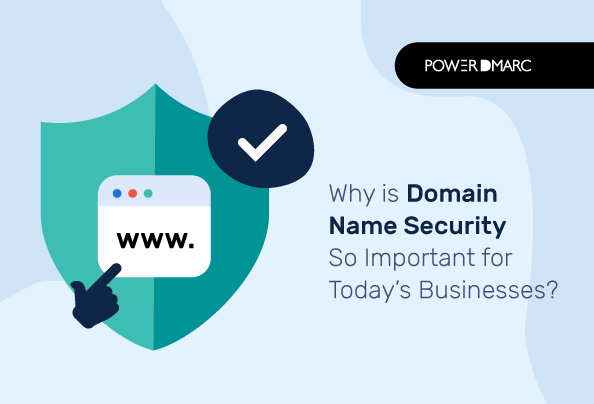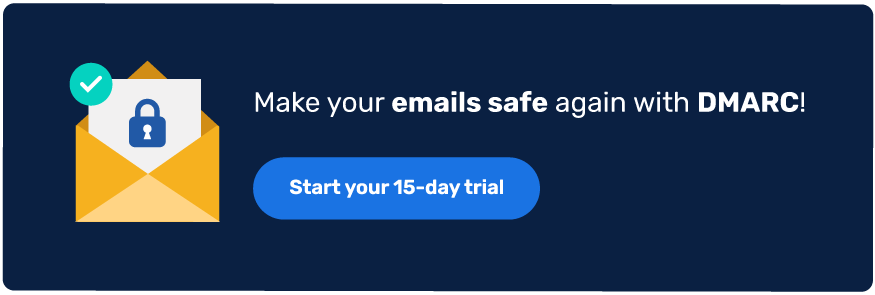Domains have grown at an explosive rate over the last decade. With a decades-long history and the power to build trust, domains have long been the premier asset for businesses, online. Domain name security is a top concern for domain holders, and today’s online threats make managing domains more complex than ever. In the 1980s, the first top-level domains were established on the internet. Since then, there have been notable developments in domain name architecture, resulting in more security challenges and costs for businesses and consumers alike. Since their inception, domains have become a channel for cyberattacks and threats to online data and security. DMARC is a widely acclaimed protocol that protects your domain name and online assets from abuse and impersonation.
But before we get to that, here are three reasons why protecting your domain name should be your topmost priority starting today:
Key Takeaways
- Your domain name is a critical asset that represents your brand and significantly impacts your online presence.
- Effective domain management is essential as it can pose security challenges for organizations with multiple domain names.
- Cybercriminals exploit domain spoofing to conduct phishing attacks, which can harm businesses financially and reputationally.
- Implementing DMARC helps protect your domain from impersonation and unauthorized email activity.
- A DMARC report analyzer simplifies domain management and provides insights into email authentication and security threats.
Your Domain is the Face of Your Company
Your domain is a reflection of your brand and is one of the most important online assets of your organization. The domain name is the digital address of your business and is an important part of your IP portfolio. It’s the first thing that potential customers and investors will see. Research shows that domains are now one of the most valuable elements of a company’s business, alongside intellectual property rights, easily identifiable assets, and shares. Domains are a vital part of any business’s IP portfolio, providing a long-term and authoritative presence on the Internet. It is essential to protect and renew them. Acquisition or abuse of domain names by cybercriminals can cause clients, customers, and partners to become inconsolable.
Domain Management is Not an Easy Task
Organizations now realize that their domain represents their business goals and creates that unified public face of the company that customers recognize when searching for products and services. As organizations become increasingly reliant on IP assets, domain management is likely to become more of a liability. The domains that are now the cornerstone of an organization’s security must be effectively managed, not just handled by internal IT teams. However, domain management poses its own set of security challenges. With the increasing number of domains each company owns, impersonating your organization for malicious ends becomes quite easy.
Did you know, 33% of organizations experienced cyberattacks specifically targeting their domain names in 2020?
Simplify Security with PowerDMARC!
Lack of Domain Name Security Increases the Risk of Domain Spoofing
Domain spoofing is a social engineering tactic, popular among cybercriminals of the digital age. A spoofed email domain accurately impersonates a valid domain and can be used to trick employees, customers, and partners who rely on your services. Spoofed domains are used to send fake emails to customers to perpetrate phishing attacks aimed at stealing sensitive data and bank details to launder money, or inject ransomware into their system. Suffice to say, it is extremely damaging to any business, both financially, as well as reputationally.
How to Secure Your Domain Name?
DMARC (Domain-based Message Authentication, Reporting & Conformance) is a mechanism letting organizations protect their domain name from impersonation, domain abuse, and spoofing. It helps stop phishing (which is the leading cause of identity theft) by creating a 100% reliable mechanism for authenticating emails that are sent from your domain. It prevents unauthorized parties from setting up email accounts using a legitimate organization’s domain name. Configuring a DMARC analyzer at your organization can provide all-around protection to your domain name, helping you make sure that your reputation remains intact and your domain can never be used for malicious purposes.
Manage Your Domains Effectively with PowerDMARC DMARC Report Analyzer
With our DMARC report analyzer, you can manage your domains across a single pane of glass, read your DMARC reports, view authentication results, and pick up on malicious activities faster. It also allows you to adjust settings on the fly for immediate changes. Whether you are a small business or enterprise, a DMARC report analyzer gives you deeper control over how you manage email authentication.
Most importantly, it gives you a single place to manage the domains that you own from multiple registrars. Our intuitive interface provides a descriptive breakdown of each failure, helping you take action against them faster than ever before.
- It provides a single, integrated solution for reading your DMARC reports
- It provides the ability to quickly identify anomalies in your reports.
- With report filtering options, this powerful module will allow you to better manage your domain’s health across multiple domains across various mail servers
- Provides a clear view of the overall picture of how your emails are protected, bounce back messages, and what malicious activities are being attempted on your domain
- Helps you save time by knowing the full picture with a reliable and clear dashboard that gives you a simple overview of your data
- Highlights any errors in your SPF, DKIM, BIMI, MTA-STS record and TLS-RPT.




